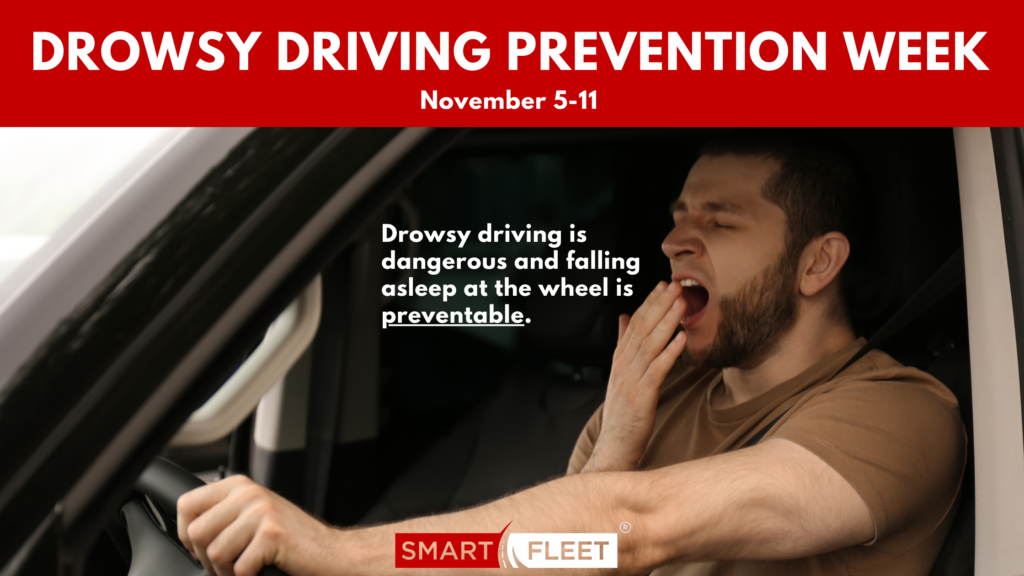In honor of Drowsy Driving Prevention Week 2023, we want to emphasize the critical importance of healthy sleep for both your productivity at work and your safety on the road with tips and information from The National Sleep Foundation.
Becoming a responsible driver begins with heightened awareness, as drowsy driving is entirely preventable.
Fatigue can significantly compromise your reaction time, diminish your alertness, cloud your judgment, and heighten the risk of accidents. Each time you prepare to hit the road, it’s essential to pause and ask yourself, “Am I fully alert and prepared to operate a 3,000-pound moving machine on public roads?”
Before setting out, whether you’re driving solo or with others, consider the following:
- Are you sleep-deprived or battling fatigue? Regular sleep problems could be a red flag. Keep in mind that getting less than 6 hours of sleep can triple your chances of falling asleep while driving.
- Are you planning to embark on extended journeys without taking necessary rest breaks?
- Will your journey take place during the night, mid-afternoon, or when you’d typically be asleep?
- Are you currently taking medications that could induce drowsiness, like antidepressants, cold tablets, or antihistamines?
- Have you been working excessively, clocking more than 60 hours a week? A packed work schedule can elevate your risk of drowsy driving by 40%.
- Does your work involve multiple jobs with shift work as a part of your routine?
- Have you consumed any alcohol? Even a small amount can impair your body’s functioning.
To be proactive, it’s wise to plan all your short and long trips in advance. Consider inviting a friend along for those extended drives, so you can rely on their assistance in identifying early signs of driver fatigue and swapping drivers when necessary.
Keep a vigilant eye out for these eight warning signs of drowsy driving:
- Difficulty focusing on the road, frequent blinking, or heavy eyelids.
- Daydreaming, wandering eyes, and disjointed thoughts.
- Struggling to recall the last few miles you drove.
- Missing exits or disregarding traffic signs.
- Repeated yawning or eye-rubbing.
- Finding it hard to keep your head up or battling the urge to nod off.
- Drifting from your lane, tailgating, or hitting a rumble strip on the shoulder.
- Restlessness, irritability, or frustration with common annoyances, such as traffic jams.
Should you notice any of these warning signs, make the responsible choice and pull over to a safe location. Take a break, stretch, or have a caffeinated beverage. Only continue driving when you feel genuinely alert and refreshed.
Certain groups of drivers are at a heightened risk of drowsy driving accidents. Research has identified five key focus groups:
- Young drivers, particularly males under 25 years old.
- Shift workers and those with extended work hours, where night shifts can increase the risk of drowsy driving by nearly six times. This includes rotating-shift workers and individuals working more than 60 hours a week, who should exercise caution.
- Commercial drivers, especially long-haul truckers. Shockingly, at least 15% of heavy truck accidents involve fatigue and sleep-deprived driving.
- Individuals with undiagnosed or untreated sleep disorders. Those suffering from untreated obstructive sleep apnea, for instance, face up to seven times the risk of falling asleep at the wheel.
- Business travelers, who often endure long hours behind the wheel or may be grappling with jet lag from previous trips.
During Drowsy Driving Prevention Week 2023, let’s all commit to prioritizing healthy sleep and raising awareness about the preventable dangers of drowsy driving. By staying vigilant and well-rested, we can help make our roads safer for everyone.

